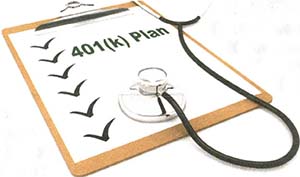Your Company's Retirement Plan - Time for a Check-up?

No question, keeping a retirement plan in compliance with tax and pension law requirements can be challenging for employers. Since mistakes in plan administration are not unusual - and can be costly if uncovered in a government audit - it's smart for employers to review their plan's operations regularly.
Common errors include:
Not covering the proper employees. Make sure that employees are given the opportunity to participate in the plan as soon as they become eligible under the plan's terms.
 Not giving employees required information. All plan participants should receive a summary plan description, summary annual report, and, when changes are made, a summary of material modifications. (Deadlines apply.) Participants are entitled to examine copies of plan documents at the employer's principal office, and plans should respond to their written requests for documents and information within 30 days.
Not giving employees required information. All plan participants should receive a summary plan description, summary annual report, and, when changes are made, a summary of material modifications. (Deadlines apply.) Participants are entitled to examine copies of plan documents at the employer's principal office, and plans should respond to their written requests for documents and information within 30 days.
Not making timely deposits. Generally, employers must deposit participant contributions and loan repayments in the plan as soon as the amounts can reasonably be segregated from the employer's general assets.
"Small" plans with fewer than 100 participants can be assured of meeting this rule if contributions are deposited within seven business days of receipt or withholding.
Not limiting contributions to the proper maximum limits. Employee deferrals and employer contributions shouldn't exceed applicable tax law limits. It's also important to apply the appropriate plan definition of compensation when allocating contributions to participant accounts.
Not following the terms of the plan document. The document serves as a roadmap for proper plan administration and should be updated as necessary when there are changes in the law.
Correction Programs
The IRS has an Employee Plans Compliance Resolution System (EPCRS) that employers can use to fix many common operational errors. The SelfCorrection Program (SCP) does not require employers to notify the IRS or pay a fee. Errors that cannot be resolved using the SCP often can be corrected (for a fee) under the Voluntary Correction Program. Additionally, the U.S. Department of Labor has a Voluntary Fiduciary Correction Program for certain fiduciary violations .•
Charitable Rollovers from IRAs
Are you planning a substantial gift to a favorite charity this year? If so, you may want to consider making that gift through an IRA charitable rollover. The charity will benefit from your generosity, and you can reap tax benefits.
Individuals age 70]12 and older can donate up to $100,000 to charity from an IRA this year without having to include the distributions in their gross income. Because the rollover amount is tax free, no income-tax deduction is available for the donation.
Why is this -strategy beneficial? For several reasons:
- Deductions for large charitable contributions are often restricted due to the tax law's percentage-of-income limitations on the itemized charitable deduction.
- The tax-free treatment of the IRA charitable distribution keeps the amount out of your adjusted gross income (AGI), which may help you qualify for other tax breaks that are limited or eliminated when AGI reaches certain levels.
- Generally, charitable IRA distributions made in 2011 count toward your required minimum distribution (RMD) for 2011.
Also, the amount of any charitable contribution you make through a charitable rollover is not part of your gross estate, which could reduce estate taxes Jater on.


